
|
Home / Articles by Pavel Platonov on the Holy Land / The Olive Savior-Ascension Convent in Jerusalem. Pavel Platonov
The Olive Savior-Ascension Convent in JerusalemTo the 100-th anniversary of the founding of the Russian monastery on the top of Mount Eleon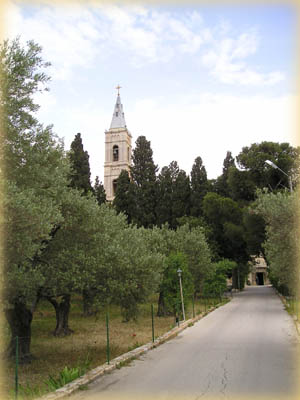 Acquisition of the site on the Mount of Olives is due to Archimandrite Antonina (Kapustin) - an outstanding church figure and head of the Russian Ecclesiastical Mission in Jerusalem. Father Antonin purchased several plots of land on the slope of the Mount of Olives. The site that served in the future for the founding of the Abode was purchased in 1870 on the very summit of the Mount of Olives near the chapel of the Ascension of the Lord. Such closeness to the deeply revered Gospel sanctum determined the decision of Archimandrite Antonin [1]. The Mount of Olives, which is of particular interest to any historian and church archaeologist, has always been in the sphere of attention of Father Antonin. During the time of the holy Equal-to-the-Apostles Queen Helena (IV century), the Empress Evdokia (fifth century) and the Emperor Justinian (VI century), many rich basilicas and monasteries, both Greek and Armenian, were built on the Mount of Olives. Interesting was the custom of that time to build churches on the Mount of Olives without domes, symbolizing the open skies before the Ascension of the Savior [2]. To decorate the place, devoid of any vegetation, and also to gain a foothold on the site bought by Father Antonin came the idea of planting trees on it [3]. This was also determined by some peculiarity of the Turkish real estate laws. Two different persons could be owners of the same site, where the land belongs to one, and the trees to another. But if the former thought to sell his land, the preferred right to acquire it belonged to the owner of the trees. It was during the planting of trees that Archimandrite Antonin came across mosaics and found the tombs, but until he got permission for the hodjet for excavation, he did not dare to continue them, and they were sprinkled with earth. At the end of May 1871, when the necessary hodjets were issued, Father Antonin was able to freely engage in his archaeological work [4]. 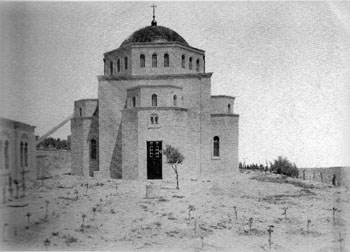 As a result of excavations conducted by Father Antonin, mosaic decorations of churches and funerary caves with important epigraphic inscriptions were found [5]. 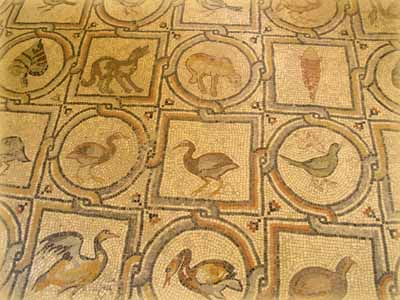 finding the honest head of St. John the Baptist Also interesting are the magnificent mosaic decorations of the floor in the chapel and in the so-called "archimandrite house", in which, after the war, the Archaeological Museum of the Mission, which was bequeathed to it by its founder, Fr. Antonin. These mosaics represent a truly classic decoration of their time and are much richer, more beautiful and more perfect than, for example, the famous Bittirian mosaics in the archeology of Palestine. Part of them - located in the chapel - science related to the IX century, except for mosaic images of fish, birds and various ornaments also contains a memorable inscription about a certain Jacob, the Armenian bishop Metzpinsky. Memorable inscriptions are found in the mosaics of funerary caves near the Museum, as well as in the most perfect, rich and perfectly preserved mosaic covering part of the floor of the lower storey of the "archimandrite house", which the well-known archaeologist Vincent attributes to the same era as the mosaics in the chapel; but recently researchers are increasingly inclined to see in it more ancient (perhaps, up to the sixth century) Byzantine traces. In addition, a large mosaic was found in the hall of the Hegumen Corps with a Greek commemorative inscription, which scientists also referred to by the sixth century [6]. These findings testified to the presence of Byzantine and Armenian churches in these places, as well as a large necropolis. 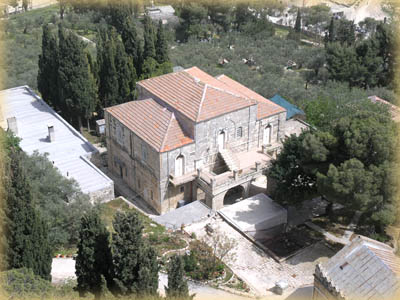 "Archimandrite House" - the building where is located
archaeological museum of Archimandrite Antonin (Kapustin)
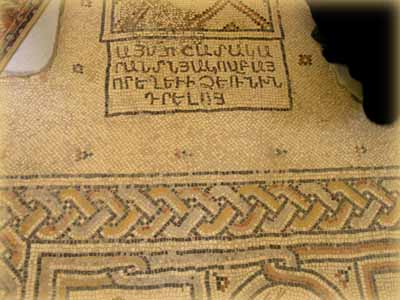 Memorial inscription about a certain Jacob Armenian bishop in the chapel of finding the honest head of St. John the Baptist 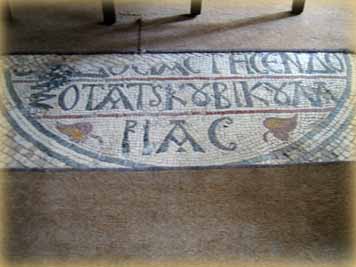 Mosaic with the Greek commemorative inscription of the VI century
in the hall of the Mother Superior's house
In 1873, Archimandrite Antonin decides to suspend all archaeological work and devote all his efforts to the building of the church. As early as December 1873, the work began and, by a lucky chance, the foundation had to be dig deep, because on that place it turned out to be a natural flat rock [8]. By the beginning of the Russian-Turkish war of 1877-1878, the church was brought to the windows, and Archimandrite Antonin was forced to leave Palestine like all members of the Russian Spiritual Mission [9]. Upon returning to the Holy Land, Father Antonin continues construction, overcoming the difficulties in obtaining various permits, firms, circumventing Turkish laws, in coaxing Turkish officials. One of the prominent officials of the Gray [10] Salim-effendi was a great fan of tea drinking and favored Father Antoninus. Father Antonin, pleasing the official often sent him gifts "tea-moskobi." I had to use not only a natural amazing charm, but also diplomatic qualities. [11] Some of the notes left in Archimandrite Antonin's unpublished diaries suggest that he himself draws a drawing of the Olive and Gorny Bells and the interior of the temple, in particular the iconostasis for the Church of Olives [12]. An interesting entry is about. Antonina, dated March 13, 1881: "The noise outside the window is unfit for 12 hours (night), drawing the future iconostasis of the Olive, the whole marble, lasting an hour to the third" ... On March 30, Father Antonin with deep satisfaction notes: "We are going to the Jordan. the church, completed by the dome.Non the walls of the monastery, noon, shelter, now to the church.There was a pretty building from the inside .Rosod to the dome "[13]. The temple with an unidentified cross had to stand for another five years, in view of not receiving the Sultan's firm, delays and bureaucratic obstacles. His solemn consecration took place on June 7, 1886, in the name of the Ascension of the Lord. The temple is an expressive monument of the Neo-Byzantine style, cross-domed in plan, with the half-wisp of the apsides, sharply prominent on all four sides of the world, protruding from the main massive quadrangle of the cathedral [15]. 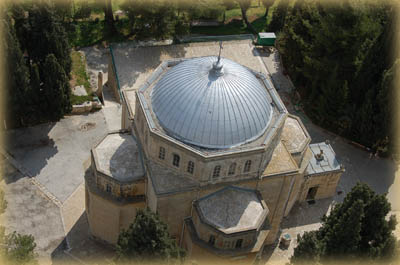 View of the Dome of the Ascension of the Ascension from the bell tower 
The architect of the temple is the Italian master - Gian Batista Biseli January 2008 Photo © Orthodox pilgrimage center "Russia in colors" in Jerusalem Before the eastern apse, a beautiful wooden iconostasis, perhaps drawn and designed by Father Antonin himself back in 1881. In the new stone floor, in front of the temple salt, Father Antonin inserted carefully collected pieces of marble slabs of the floor of a fifth-century female monastery found during excavations. [16] 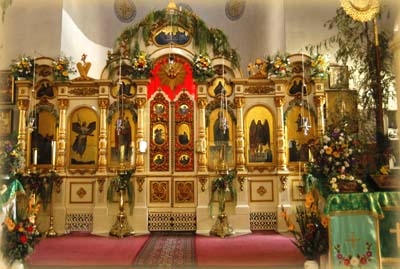 The iconostasis, possibly designed and drawn
by Archimandrite Antonin himself
In parallel with the church went the construction of the bell tower, as noted above, the drawing of which was painted by Father Antonin himself. The construction of the bell tower, as well as the temple of Father Antonin personally controlled, often visiting the Mount of Olives or watching the work in a telescope from the window of the building of the Mission [18]. The bell tower was built by the same Italian masters. It was later named "Russian Candle". The height of the bell tower was 64 meters, and in its architecture it is exactly like the medieval Italian campaigners [19]. The whole event for Jerusalem was the arrival of the Eleon bell. He was commissioned by the pious fan of the Holy Places Solikamsk merchant Alexander Ryazantsev. Before that, he had already donated several thousand rubles at various times for the needs of Father Antonin. And his final contribution to the construction of the future Russian monastery was the luxurious 308-pood bell ordered in Moscow with a remarkable ornament of high reliefs [20] and inscriptions [21]. Kolokol AV Ryazantsev was sent from Odessa on the ship "Kornilov" on March 12, 1884 and unloaded to the shore of Jaffa [22]. After a while the bell was moved from Jaffa to Jerusalem. Here is how Father Antonin himself describes this event:  "And 105 people (two-thirds of the women) hastily arrived in Jaffa and set to work, thanks to the general enthusiasm, for 7 days the bell, despite a thousand difficulties, was safely delivered (on hands!) To our buildings. In the evening he had an enthusiastic meeting, raising the whole city to his feet, then the whole mass of pilgrims undertook to haul the bell to St. Eléon, to the place of his appointment "[23]. On arrival at the Russian buildings, there are not hundreds, but thousands of people moved to carry the bell to Mount Olivet, the road to which left much to be desired. On the Mount of Olives, it was narrow paths cut in the rock, winding between the rocks ledges in 35-40 degrees of steepness. But for Russian Orthodox fans this was not an obstacle, and during the stops they sang "Save Thy Lord thy people, with a loud mention of the name of the adored monarch" [24].
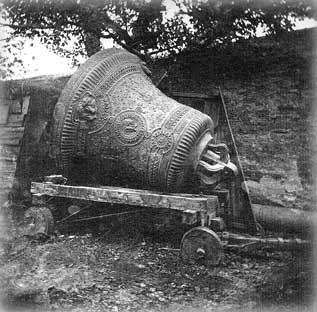 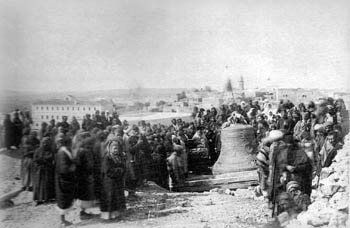 The bell is delivered to Eleon Installation of the bell inside the foundation of the future bell tower 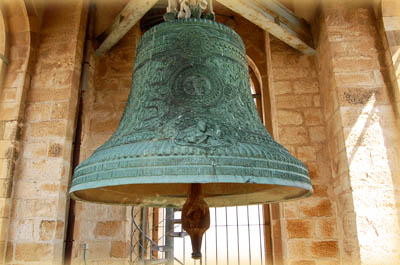 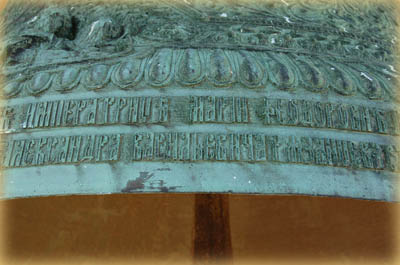 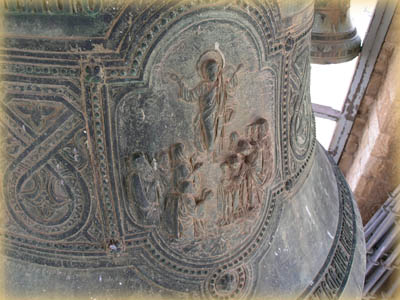 In addition to the Savior-Ascension Cathedral in the Olive monastery, several other temples were built. After the execution of John the Baptist by Herod the Fourfold, the body of the Baptist Lord was secretly buried by the disciples. The head was hidden by one of Herod's servants, a secret Christian, and was buried then in the suburban royal house on the Oliveon. Subsequently, with the money of a Russian woman philanthropist Irina Grigorievna Silayeva, a church was built on the site of her acquisition, the mosaic floors of which were also discovered and uncovered by Father Antonin during the excavations of Olivet. Separately, a mosaic on the floor of the depression, where the honest head of the Precursor was lying [27]. 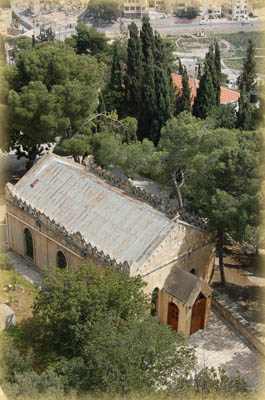 Chapel of finding an honest head
St. John the Baptist View from the bell tower
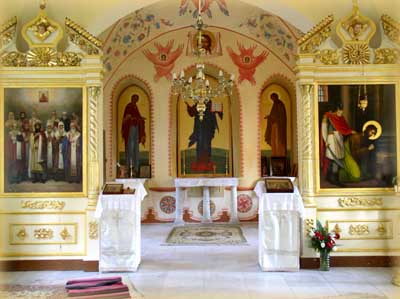 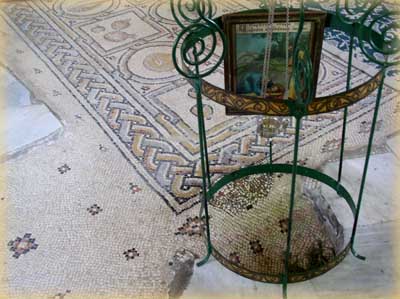 Behind the monastery buildings is the house of the head of the Russian Ecclesiastical Mission; in the lower floor of this building was a museum of antiquities collected by Father Antoninus. In the northeast corner of the site strikes its architecture a long building with a flat roof. Here in 1907, with the successor and continuer of the Antonin case, Archimandrite Leonid (Sentsov), the construction of a large cathedral church was begun in the name of the Last Judgment, but the events of the First World War and then the revolution put an end to the construction. Only managed to finish building the lower church in the name of St. Philaret the Merciful, who now serves as a refectory for the nuns of the monastery. [29] The Russian site on the Eleonion with the Ascension church began to attract a lot of pilgrims and Archimandrite Antonina came up with the idea to build on this site several hospitable buildings in the form of a separate building of six rooms and other structures. On March 24, 1894, on the eve of the Annunciation, the Palestinian ascetic Archimandrite Antonin departed to the Lord. A bell on the Mount of Olives announced this sad event. His grave is in the north wing of the Ascension church [30]. Father Archimandrite bequeathed himself to be buried in the temple on the Mount of Olives on the right side. When digging the grave it turned out that the rock in that place prevents this and therefore the grave was arranged on the left side of the temple [31]. After the period of the service of Father Antonin, the most zealous works on the beautification of the Mount of Olives were continued by Father Superior Parfenius and the new head of the Russian Ecclesiastical Mission in Jerusalem, Archimandrite Leonid (Sentsov). New buildings were made, old ones were restored. Already in 1905, on the Mount of Olives, there was a female monastic community and its first meeting was performed on August 12 (according to the style) on the birthday of Archimandrite Antonin (Kapustin). Officially, the Most Holy Synod of the Russian Orthodox Church established the Women's Community in Olone in response to the request of Archimandrite Leonid in 1906. In the Decree of the Holy Synod of December 2, 1906, No. 13420, it was said that the women's hostel on the Oliveon is recognized as a community, and the rules approved for the Gorny community in 1898 apply. In addition, it was proposed to Archimandrite Leonid before the announcement of the decree on the establishment of the community to ask for this blessing of the Patriarch of Jerusalem [32]. After the approval of the women's community, they began building new buildings, a hotel, an almshouse, and opened a gold embroidery and icon painting workshops [33]. Initially there were 15 sisters in the community. By 1907, the number of inhabitants increased to 70, and in August 1914 there were more than 100 sisters in the community [34]. In 1909, a tragedy occurred on Eleon. One night hegumen Parfenius was killed. The malefactors were looking for money (the murder was for the purpose of robbery), but apart from various trifles nothing was found from the worker of God in the Oliveon. Father Parfenius was buried near the coffin of his mentor - Archimandrite Antonin [35]. Only three years this podvizhnik piety managed to work on Olive. It was Archimandrite Leonid (Sentsov) who headed the Olive community, together with the elderly nun Evpraksia, who was the hegumen of Partheniy. [36] 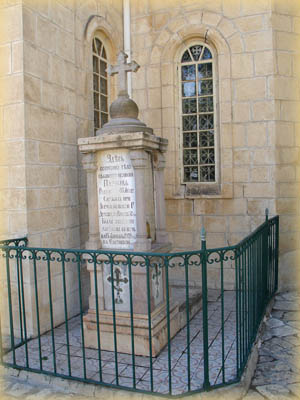 In February 1917, Russia was swept by the February revolution and more and more plunged into revolutionary madness. The head of the Russian Ecclesiastical Mission in Jerusalem, due to the war in Alexandria, arrives on March 1, 1917, at the Local Council of the Russian Orthodox Church that opened in Moscow. He takes part in the discussion of many missionary issues, and especially those related to the Russian Ecclesiastical Mission in Jerusalem. In the fall of 1918 he fell ill, and on 10 November 1918 Archimandrite Leonid died. At his burial was attended by the rector of the Jerusalem metochion in Moscow, Archimandrite Athanasius, as a symbol of the blessing of Jerusalem to the laborer in Holy City [41]. On December 11, 1917, the troops of the British led by General Allenby entered Jerusalem and an entirely new period began in the Holy Land. The British occupied most of the Russian buildings after the Turkish soldiers, including half of the building of the Russian Ecclesiastical Mission, using premises for the Supreme Mandate Court of Palestine. [42] Part of the soldiers settled on Eleon, helped the sisters, supplying them with bread, tea and sugar. Early in 1919 older sisters returned from Alexandria, and in June 1919 the Ascension church was printed. Soon the clergy are returned to the community, headed by the senior member of the Mission and the peaceful life of the monastery begins to be restored [43]. Since that time, communication with Russia has practically ceased, and all Russian churches in Palestine are subordinate to the WUZ [44]. In 1923 there was a case when 30 sisters of the Olive community filed a petition to the High Commissioner of the British Mandate, expressing the desire to be independent in economic matters, and in the spiritual sense to be dependent on the Patriarch of Jerusalem, and not on the head of the Russian Ecclesiastical Mission. Since then, the abbots have been placed at the head of the monastery with their elevation to the rank of abbess [45]. Under Abbess Tamara, a small hospital was opened in the monastery. 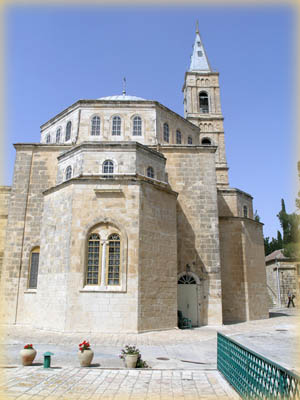 ВIn 1924 the Olive community at the petition of Metropolitan Anthony (Khrapovitsky), with the blessing of the patriarch of Jerusalem Damian, began to be called a monastery. Since then, and to this day, the monastery site together with the hotel, two cemeteries, olive and pine groves, covering an area of 54,000 square meters and surrounded by a stone fence with a total length of more than one and a half kilometers in circumference is under the jurisdiction of the Russian Orthodox Church Outside of Russia.
Notes[1] TsGIA St. Petersburg. f. 796., 1858-1890. op. 205. No. 462. Cited. by O.L. Zerpickaya. "Archimandrite Antonin Kapustin and Russian shrines in the Holy Land." Journal of St. Petersburg Diocesan Newspaper No. 21-22, 2000.
[2] Archimandrite Cyprian (Kern). O. Antonin (Kapustin), an archimandrite and head of the Russian Ecclesiastical Mission in Jerusalem (1817-1894). Chapter VIII. The Jerusalem years. Стр. 170.
[3] Diary of Father Antonin for 1873 allows to restore details: "January 5. After drinking tea, went to Eleon. Screaming with Yakub about the pits dug under the olives. January 9. Departure to the Eleon box with 60 cypresses. Zaselenaet St.Gora. 11 January. Drive to Eleon. Cypress considerations. Future groves, alleys, curtains, parks, and all other spaces. " Cit. on the book "Russian excavations on the Mount of Olives" [4] S.M. Dmitrevsky. "Russian excavations on the Mount of Olives." Стр. 55 [5] Ibid. [6] Articles about. Antonina in the "Church Vestnik" of 1876, No. 32 and 1880, No. 28 and more recently the article by E. S. Lukyanova "Le Musee de couvent du du Mt de" Oliviers a Jerusalem "in" Bulletin de 1 "Institut d" Egipte ", t. XIII (1931). p 101. Quoted from the book of Archimandrite Cyprian (Kern). [7] Archimandrite Cyprian (Kern). O. Antonin (Kapustin), an archimandrite and head of the Russian Ecclesiastical Mission in Jerusalem (1817-1894). Chapter VIII. The Jerusalem years. Стр. 171 [8] S.M. Dmitrevsky. "Russian excavations on the Mount of Olives." Publishing house "Indrik". Стр. 61 [9] Archimandrite Cyprian (Kern). O. Antonin (Kapustin), an archimandrite and head of the Russian Ecclesiastical Mission in Jerusalem (1817-1894). Chapter VIII. The Jerusalem years. Стр. 171 [10] Serai - (French serail, from Persian serai, Turkish saray - palace), the European name of the Sultan's palace and its internal chambers (harems) in the Ottoman Empire. [11] Archimandrite Cyprian (Kern). O. Antonin (Kapustin), an archimandrite and head of the Russian Ecclesiastical Mission in Jerusalem (1817-1894). Chapter VIII. The Jerusalem years. Стр. 171 [12] N.N. Lisovoi. "Russia in the Holy Land. Documents and materials ". Volume 2. Russian Ascension Monastery on the Mount of Olives. Стр. 598 [13] Ibid. [14] N. Lisovoi. Guide to the Holy Land. [15] N.N. Lisovoi. "Russia in the Holy Land. Documents and materials ". Volume 2. Russian Ascension Monastery on the Mount of Olives. Стр. 598 [16] Ibid. [17] Ibid. [18] O.L. Zerpickaya. "Archimandrite Antonin Kapustin and Russian shrines in the Holy Land." Journal of St. Petersburg Diocesan Newspaper No. 21-22, 2000. [19] Campanila - (Italian campanile), a bell tower in the Italian architecture of the Middle Ages and the Renaissance. The Campanile was built in the form of a 4-faceted (sometimes round) tower, which, as a rule, stood separately from the temple. The prototype of Campanilla was the city's watchtowers. The increase in the number or dimensions of the openings upward (the lower floors were mostly deaf) gives Campanile harmony and lightness. (BES) [20] The relief is a relief sculpture in which the image protrudes above the background plane by more than half its volume. The high relief is used for architecture. Haut - high + Relief - convex thread. (Dictionary of Natural Sciences) [21] S.M. Dmitrevsky. "Russian excavations on the Mount of Olives." Publishing house "Indrik". Стр. 63 [22] M.I. Osipov. Report ... p.457 [23] Cit. A.A. Dmitrievsky "The head of the Russian Ecclesiastical Mission in Jerusalem, Archimandrite Antonin (Kapustin) as an actor for the benefit of Orthodoxy in the East, and in particular in Palestine. (Concerning the Decade from the Date of His Death) // IOPS Reports. 1904. T. XV.Vyp.2., P.95-148). [24] S.M. Dmitrevsky. "Russian excavations on the Mount of Olives." Publishing house "Indrik". Стр. 64 [25] Ibid. [26] Ibid. [27] N.N. Lisovoi. "Russia in the Holy Land. Documents and materials ". Volume 2. Russian Ascension Monastery on the Mount of Olives. Стр. 599 [28] Ibid. [29] Ibid. [30] Archimandrite Nicodim (Rotov). The history of the Russian Ecclesiastical Mission in Jerusalem. Chapter IV. Russian Spiritual Mission from the death of his father Antonin before the war of 1914. P.270 [31] Ibid. [32] Archimandrite Nicodim (Rotov). The history of the Russian Ecclesiastical Mission in Jerusalem. Chapter IV. Russian Spiritual Mission from the death of his father Antonin before the war of 1914. P.372 [33] The Russian Orthodox Church Outside of Russia, ed. A.A. Sologub. 1918-1968 gg. Volume I. P. 425 [34] Anatoly Pashkov. "Baturin-Baturin. The Priestly Family of the Karustins. " Iset Publishing House. P.171 [35] Archimandrite Nicodemus (Rotov). The specified product. P.372 [36] Professor A.A. Dmitrievsky. In memory of a member of the Russian Ecclesiastical Mission in Jerusalem Fr. Hegumen Parfenius, who was killed on January 14, 1909 on the Mount of Olives. St.P. 1909. 7-th [37] Archimandrite Nicodim (Rotov). The specified product. P.372 [38] The Russian Orthodox Church Outside of Russia, ed. A.A. Sologub. 1918-1968 gg. Volume I. p. 426 [39] Anatoly Pashkov. "Baturin-Baturin. The Priestly Family of the Karustins. " Iset Publishing House. P.172 [40] The Russian Orthodox Church Outside of Russia, ed. A.A. Sologub. 1918-1968 gg. Volume I. P. 425 [41] Archimandrite Nicodim (Rotov). The specified product. P.377 [42] Ibid. Стр. 380. [43] The Russian Orthodox Church Outside of Russia, ed. A.A. Sologub. 1918-1968 gg. Volume I. p. 428
[44] WUCU - Higher Church Abroad.
[45] Archimandrite Nicodim (Rotov). The specified product. P.388 |
| © 2005 The Orthodox Scientific Educational Society "Russia in colours" in Jerusalem |
||